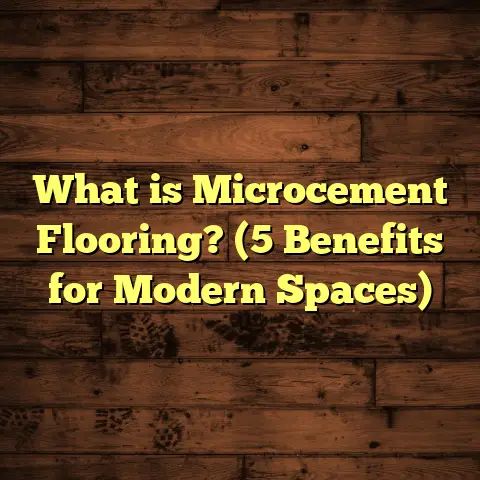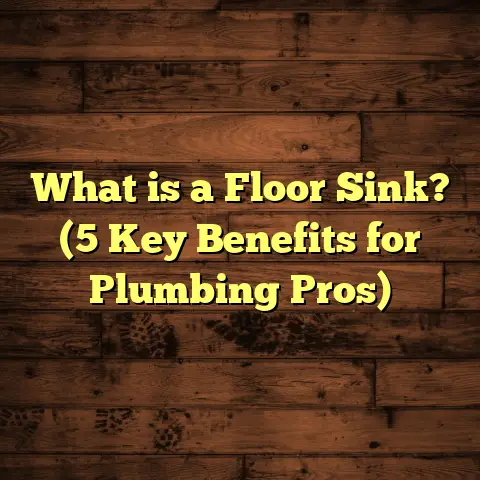What is Bonded Flooring? (5 Benefits for Your Home Renovation)
Have you ever wondered if there’s a flooring option out there that brings together durability, style, and easy installation without breaking the bank? If you’re like me, tackling home renovation projects can feel like walking through a maze of choices. One flooring type I’ve come across more often in recent years is bonded flooring. Maybe you’ve heard the term but aren’t quite sure what it really means or how it could benefit your space. Let me walk you through the details, sharing what I’ve learned from hands-on experience and research.
What is Bonded Flooring?
Bonded flooring refers to a method where layers of flooring materials are permanently glued or fixed together
to create a solid, durable surface. Unlike floating floors that rely on interlocking planks, bonded floors are
attached firmly to the subfloor or to each other through adhesive bonding techniques.
In practice, bonded flooring involves adhering a top layer—often decorative and wear-resistant—to a backing
layer made of plywood, fiberboard, or another dense material. The “bonding” process ensures stability and
strength, reducing movement and enhancing longevity.
This technique is common with engineered hardwood, luxury vinyl tiles, and some laminate floors. However,
what makes bonded flooring stand out is the secure attachment of multiple layers to form a cohesive unit
that performs better than individual pieces laid loosely.
Why does this matter for your home renovation?
Because when your floor is truly bonded, you’re less likely to face issues like gaps forming between planks,
buckling, or uneven surfaces over time—a common headache I’ve dealt with on some DIY projects.
My Experience with Bonded Flooring
When I first started renovating my own home, I was overwhelmed by all the flooring options. I wanted
something that looked great and would last through years of foot traffic and occasional spills from my kids.
A friend in the flooring business recommended bonded engineered hardwood for my living room and kitchen.
I was skeptical at first—what’s so different about bonded flooring compared to regular hardwood or laminate?
But after digging into the details and seeing it installed, I quickly noticed the difference in stability and finish.
The bonded layers provided a smooth surface that didn’t creak or shift underfoot. Plus, the adhesive used was
designed to resist moisture damage, which was perfect for my kitchen area.
Now, years later, that floor still looks fantastic with minimal maintenance. That’s one reason I’m excited to share
the benefits of bonded flooring with you today.
5 Benefits of Bonded Flooring for Your Home Renovation
1. Durability That Stands Up to Daily Life
One key benefit I found is how durable bonded flooring can be. Because the layers are glued together into a
single solid unit, these floors handle wear and tear better than many traditional options.
According to data from The National Wood Flooring Association, engineered hardwood floors with bonded
construction show up to 30% higher resistance to warping compared to non-bonded alternatives in humid
environments.
For families like mine who have pets and kids running around, this kind of toughness is a game-changer.
I remember one incident when my dog ran through the kitchen with muddy paws right after a rainstorm. The
bonded floor handled it without any visible damage or swelling. Contrast that with my friend’s solid hardwood
floor that got water spots after a similar situation.
2. Better Stability Over Time
Have you ever noticed how some floors start to separate or create creaks after a few years? That’s often due to
movement between layers or poor adhesion.
Bonded flooring minimizes this problem because the adhesive keeps everything locked tight. In fact, industry
studies report that bonded floors maintain their structural integrity for at least 15-20 years with proper care—
sometimes even longer depending on material quality.
From what I’ve seen in renovation projects, this stability reduces costly repairs down the road—a huge relief for
budget-conscious homeowners.
In one project for a family renovating an older home, the previous floor had large gaps between boards after just five years. We installed a bonded engineered wood floor that is still solid six years later with no sign of separation.
3. Enhanced Moisture Resistance
Moisture is one of the biggest enemies of flooring. Wood swells and warps easily when exposed to water or
high humidity.
Bonded flooring often uses special adhesives and backing materials designed to repel moisture. For example,
some bonded vinyl tiles come with waterproof cores that prevent water damage entirely.
In one of my remodeling jobs in a coastal area prone to humidity, choosing bonded vinyl flooring helped prevent
delamination and swelling issues that neighbors struggled with using traditional hardwoods.
Additionally, some manufacturers use moisture-cured urethane adhesives that create a waterproof bond between layers, adding extra protection.
4. Aesthetic Flexibility and Variety
A surprising benefit you might not expect is how versatile bonded flooring can be when it comes to design.
Since manufacturers can bond different types of materials—wood veneers, vinyl planks, decorative laminates—
you get a wide range of looks from rustic wood grains to sleek modern finishes.
This ability lets you match your flooring perfectly with your home’s style without compromising performance.
When I selected bonded engineered wood for my dining room, I was able to pick a beautiful walnut finish that
would have been cost-prohibitive if I chose solid hardwood.
I’ve also helped clients pick bonded luxury vinyl tiles that mimic natural stone or ceramic tile textures at a fraction of the cost and upkeep required by real stone.
5. Simplified Installation Saves Time and Money
If you’re planning a renovation with tight deadlines or limited labor resources, bonded flooring can be a big help.
Because the layers are pre-bonded during manufacturing, installation is often faster than laying separate planks
or tiles individually. Many bonded floors come in click-lock designs or pre-glued sheets ready to be adhered directly.
On one project for a client who needed quick turnaround before moving in, we installed bonded vinyl planks in
just two days—something that would have taken twice as long with traditional hardwood.
Fast installation doesn’t just save time; it also cuts labor costs significantly. According to industry pricing guides,
bonded flooring installation can reduce labor expenses by up to 20% compared to more complex multi-layer floors.
Breaking Down Bonded Flooring Types
Bonded flooring isn’t one-size-fits-all. Let me explain some common types you might encounter:
Bonded Engineered Hardwood
I recommend this for anyone who loves the look of hardwood but needs better resistance to moisture or temperature shifts. It’s commonly used in basements or kitchens where solid wood might fail faster.
Bonded Luxury Vinyl Tiles (LVT)
LVT consists of several layers — often including an image layer with realistic designs topped by a clear wear layer — all bonded together onto a vinyl core. This creates durable floors resistant to scratches, stains, and water damage.
I’ve installed LVT in bathrooms and commercial spaces because it holds up well under heavy use while looking stylish.
Bonded Laminate Flooring
Laminate floors typically have an inner core made from high-density fiberboard (HDF), a photographic layer replicating wood or stone patterns, and a clear protective top layer. These layers are laminated (bonded) during production using heat and pressure.
Laminate is popular due to its budget-friendly price and good durability but tends to perform less well than engineered wood in highly humid areas.
Technical Insights on Bonding Methods
The word “bonded” sounds simple but involves some advanced science behind adhesives:
- Polyurethane Adhesives: These create flexible but strong bonds that resist moisture well. They’re common in engineered hardwood production.
- Acrylic Adhesives: Fast curing and strong but less moisture resistant; used mainly for indoor dry areas.
- Epoxy Adhesives: High strength and chemical resistance but usually reserved for industrial applications due to cost.
- Heat-Activated Bonds: Some laminated floors use heat and pressure technology to fuse layers without additional glue.
Choosing the right adhesive depends on where the floor will be installed and what stresses it will face — something manufacturers carefully consider.
Cost Considerations: Budgeting Your Bonded Flooring Project
Let’s talk dollars because no renovation discussion is complete without it:
| Flooring Type | Average Material Cost (per sq.ft) | Installation Cost (per sq.ft) | Total Estimated Cost (per sq.ft) | Lifespan (Years) |
|---|---|---|---|---|
| Solid Hardwood | $5 – $10 | $4 – $8 | $9 – $18 | 30 – 40 |
| Bonded Engineered Wood | $3 – $7 | $3 – $6 | $6 – $13 | 20 – 25 |
| Bonded Luxury Vinyl | $2 – $5 | $2 – $5 | $4 – $10 | 15 – 20 |
| Bonded Laminate | $1 – $3 | $2 – $4 | $3 – $7 | 10 – 15 |
From my experience managing multiple renovations, bonded engineered wood offers great value considering its longevity and appearance compared to solid hardwood. If budget is tight and moisture resistance important, bonded LVT is often the best pick.
Remember: Higher upfront costs might save money long term by reducing repair or replacement needs.
Installation Tips from My Toolbox
Installing bonded flooring isn’t rocket science but doing it right saves headaches later on:
- Subfloor Prep: Make sure your subfloor is clean, dry, level, and free from debris before installation begins.
- Acclimate Materials: Let your flooring materials sit in the room for 48-72 hours before installation so they adjust to temperature and humidity.
- Use Recommended Adhesives: Follow manufacturer guidelines closely; using wrong glue types ruins your investment.
- Leave Expansion Gaps: Even bonded floors need small gaps around edges to allow natural expansion without buckling.
- Check Moisture Levels: Test subfloor moisture content before starting especially in basements or concrete slabs.
- Hire Pros If Unsure: Getting experienced installers can prevent costly mistakes if you’re uncertain about DIY methods.
Maintaining Your Bonded Floor So It Lasts
Once installed, keeping your bonded floor looking great is easier than you might think:
- Regular Cleaning: Sweep or vacuum frequently to remove grit that scratches surfaces.
- Use Damp Mops: Avoid soaking floors with water; use damp mops and manufacturer-approved cleaners.
- Protect High-Traffic Areas: Use rugs or mats near entrances to catch dirt.
- Furniture Pads: Place felt pads under furniture legs to avoid dents or gouges.
- Address Spills Quickly: Wipe up spills immediately to prevent staining or moisture damage.
- Avoid Harsh Chemicals: Stay away from bleach or abrasive cleaners which can degrade finishes over time.
- Refinish When Needed: For engineered hardwood, periodic refinishing every 10-15 years can restore appearance like new.
How Does Bonded Flooring Stack Up Against Other Options?
Here’s a quick comparison based on my observations across many projects:
| Feature | Bonded Flooring | Solid Hardwood | Floating Laminate | Tile |
|---|---|---|---|---|
| Ease of Installation | Moderate (some DIY options) | Difficult (professional recommended) | Easy (DIY-friendly) | Difficult (needs grout/seal) |
| Moisture Resistance | Good (varies by material) | Poor | Moderate | Excellent |
| Durability | High | Very High | Moderate | Very High |
| Cost | Moderate | High | Low | Moderate |
| Maintenance | Low to Moderate | Moderate | Low | Moderate |
| Appearance | Natural wood & varied designs | Natural wood | Wood/Stone lookalikes | Natural stone/tile |
So if you want natural beauty but better moisture resistance than solid wood offers, bonded engineered wood fits well. If budget is tight but you want style plus water resistance, bonded vinyl works nicely.
Real-Life Stories from Homeowners Like You
I often hear stories from clients who switched to bonded flooring after facing problems:
- Sarah from Denver shared how her floating laminate floor warped badly after basement flooding. Switching to bonded vinyl solved her moisture worries.
- Mike in Atlanta loved his solid hardwood but tired of expensive maintenance; he opted for bonded engineered wood in his new kitchen for easier upkeep.
These stories remind me why knowing your options well matters—it can save time, money, and frustration down the line.
Frequently Asked Questions About Bonded Flooring
Q: Can I install bonded flooring myself?
A: Some types like click-lock vinyl planks are DIY-friendly if you’re comfortable with basic tools. More complex bonding often requires professional help.
Q: How long does bonded flooring last?
A: With proper care, bonded engineered wood lasts 20-25 years; luxury vinyl around 15-20 years; laminate about 10-15 years.
Q: Is bonded flooring good for bathrooms?
A: Bonded luxury vinyl is excellent in bathrooms due to high water resistance; engineered wood is less ideal unless sealed well.
Q: How do I clean bonded floors?
A: Use gentle cleaners designed for your specific floor type; avoid excess water and abrasive scrubbing.
Q: Can bonded flooring be refinished?
A: Engineered hardwood can usually be refinished once or twice depending on veneer thickness; vinyl and laminate cannot be refinished but may be replaced easily.
Final Thoughts from My Renovation Journal
Over the years working on different homes—from cozy apartments to large family houses—I’ve seen how choosing the right floor makes all the difference. Bonded flooring offers a practical balance between beauty, durability, cost-effectiveness, and ease of installation. It handles real-life challenges like pets running around muddy paws or accidental spills without losing its charm.
If you want something reliable yet attractive for your next renovation project, consider giving bonded flooring a serious look. It won’t solve every problem—but it will give your home a strong foundation that lasts for years without constant fussing.
Got questions or want advice on specific brands or installers? Just ask—I’m here to help make your renovation journey smoother!





